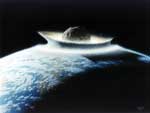Meteorite fragment makes an impact
Published: 11 May 2006
First ever solid remains of a meteorite revealed
A fossilised fragment from a giant meteorite that crashed to Earth millions of years ago could lead to a re-think about the effects of asteroid collisions with our planet. The discovery is published in Nature this week (11 May 2006.)
An international research team, including a University of Glasgow academic based at Scottish Universities Environmental Research Centre (SUERC), uncovered the 25cm sized fragment, the first of its kind ever found, in the frozen magma pool at the bottom of the giant Morokweng crater in South Africa. The unique find will create a direct window to what was happening in the solar system at the time of impact, 144 million years ago.
Normally, meteorites are changed by the process of impact. Most are small and ineffective but a few cause huge craters on the Earth's surface wiping out everything in the affected area. Scientists previously believed that any asteroid capable of generating a crater larger than 4 kilometres in diameter would be totally destroyed on impact, but the new discovery challenges that view.
Morokweng is a much larger crater of 70 kilometres diameter, and suggests that the asteroid may have struck the Earth at a lower speed than has been generally assumed.
The researchers found the meteorite fragment whilst assisting a company searching for copper and nickel in the crater.
Dr Iain McDonald the UK team leader, of Cardiff University's School of Earth, Ocean and Planetary Sciences said: "This was a huge stroke of luck, as had the borehole been sited just a metre away, it may have missed the object altogether. For the first time it is possible to hold in your hand an actual piece of a giant asteroid that hit the Earth. This intact fragment may tell us a lot more about the insides of asteroids than we currently know."
Dr Adrian Boyce, of Glasgow University and Senior Research Fellow at the Scottish Universities Environmental Research Centre (SUERC), added: "This story has a further twist as the fragment shows some striking differences when compared with other meteorites ヨ such as its absence of iron-nickel metal. The composition suggests that the asteroid came from a source not found in other objects reaching the Earth so far."
To highlight its unique status, fragments of the asteroid will be on display at the Science Museum's Antenna news gallery in London from Thursday 11th May.
The international team came from South Africa, America, Canada and the universities of Cardiff, and Glasgow. The UK researchers were assisted by funds from the Leverhulme Trust and the Natural Environment Research Council (NERC) via its Isotope Community Support Facility.
Media Relations Office (media@gla.ac.uk)
For more details please contact the Media Relations Office on 0141 330-3535.
First published: 11 May 2006
<< May


